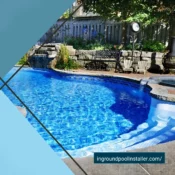Inground Pool Maintenance: Essential Tips for Effective Water Treatment

Inground Pool Maintenance: Essential Tips for Effective Water Treatment
Just as a seasoned chef skillfully balances flavors in a gourmet dish, you too must master the art of maintaining the right chemical balance in your inground pool. It's a delicate dance involving pH levels, alkalinity, and sanitizer levels, but don't let that deter you.
We're here to help you understand the nuances of pool water chemistry and provide you with all the essential tips for effective water treatment. With the right knowledge and a consistent approach, you'll ensure your pool remains pristine, safe, and enjoyable all year round.
But, how do you get there? Let's step into the world of pool maintenance to find out.
Understanding Pool Water Chemistry
How well do you understand the chemistry of your pool water? It's more than just a clear shimmering oasis. It's a complex concoction of chemicals that need your careful management. When you maintain the right balance of pH, alkalinity, and chlorine, you're not only ensuring a safe swimming environment but also preserving your pool's structural integrity. You're part of a savvy group of pool owners who take this responsibility seriously.
Don't be intimidated by technical terms. pH is simply a measure of how acidic or basic your pool water is, while alkalinity indicates the water's resistance to pH changes. Chlorine? It's your primary sanitizer, keeping the water free from harmful bacteria. So, embrace your role as your pool's chemist – it's essential for its health and yours.
Regular Pool Cleaning Practices
While mastering the chemical balance is crucial, don't overlook the importance of regular physical cleaning to keep your inground pool in top shape.
- Skimming: Regularly skim your pool's surface to remove debris. This not only makes your pool aesthetically pleasing but also prevents the debris from sinking, which can lead to algae growth.
- Brushing: Use a pool brush to scrub the walls and floor at least once a week. This prevents the buildup of algae and calcium deposits.
- Vacuuming: A pool vacuum can help remove dirt that's settled on the bottom.
- Cleaning filters: Lastly, don't forget to clean your pool's filters. Dirt and debris can clog them over time, reducing their efficiency.
Don't underestimate these steps. They're essential to maintaining your pool's cleanliness and longevity.
All Categories
- Concrete
- Concrete
- Concrete pools
- Construction
- Custom Features and Add-ons
- Design
- Design
- Design
- Design & Construction
- Design and Planning
- Features & Customization
- Infinity edge
- inground pool
- inground pool builder
- inground pool installer
- Installation
- Installation Process
- Legal & Administrative
- Materials
- planning and design
- Pool Aesthetics and Customization
- Pool Design
- Pool Equipment
- Pool Features
- Pool Features
- Pool Installation Process
- Pool Materials
- Pool Materials
- Pool Types
- Project Planning
- Renovation
- Resurfacing
- top sights
- Types of Inground Pools
- Types of Inground Pools
- Types of Inground Pools
- Types of Inground Pools
- Water Treatment



